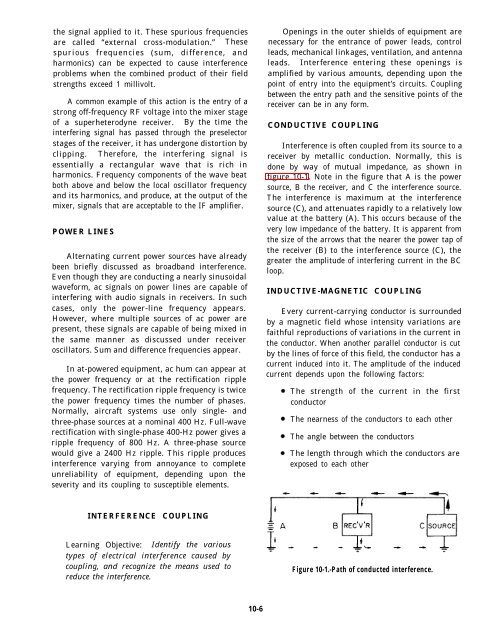Aviation Electronics Technician 1 - Historic Naval Ships Association
Aviation Electronics Technician 1 - Historic Naval Ships Association
Aviation Electronics Technician 1 - Historic Naval Ships Association
Create successful ePaper yourself
Turn your PDF publications into a flip-book with our unique Google optimized e-Paper software.
the signal applied to it. These spurious frequenciesare called “external cross-modulation.” Thesespurious frequencies (sum, difference, andharmonics) can be expected to cause interferenceproblems when the combined product of their fieldstrengths exceed 1 millivolt.A common example of this action is the entry of astrong off-frequency RF voltage into the mixer stageof a superheterodyne receiver. By the time theinterfering signal has passed through the preselectorstages of the receiver, it has undergone distortion byclipping. Therefore, the interfering signal isessentially a rectangular wave that is rich inharmonics. Frequency components of the wave beatboth above and below the local oscillator frequencyand its harmonics, and produce, at the output of themixer, signals that are acceptable to the IF amplifier.POWER LINESAlternating current power sources have alreadybeen briefly discussed as broadband interference.Even though they are conducting a nearly sinusoidalwaveform, ac signals on power lines are capable ofinterfering with audio signals in receivers. In suchcases, only the power-line frequency appears.However, where multiple sources of ac power arepresent, these signals are capable of being mixed inthe same manner as discussed under receiveroscillators. Sum and difference frequencies appear.In at-powered equipment, ac hum can appear atthe power frequency or at the rectification ripplefrequency. The rectification ripple frequency is twicethe power frequency times the number of phases.Normally, aircraft systems use only single- andthree-phase sources at a nominal 400 Hz. Full-waverectification with single-phase 400-Hz power gives aripple frequency of 800 Hz. A three-phase sourcewould give a 2400 Hz ripple. This ripple producesinterference varying from annoyance to completeunreliability of equipment, depending upon theseverity and its coupling to susceptible elements.Openings in the outer shields of equipment arenecessary for the entrance of power leads, controlleads, mechanical linkages, ventilation, and antennaleads. Interference entering these openings isamplified by various amounts, depending upon thepoint of entry into the equipment’s circuits. Couplingbetween the entry path and the sensitive points of thereceiver can be in any form.CONDUCTIVE COUPLINGInterference is often coupled from its source to areceiver by metallic conduction. Normally, this isdone by way of mutual impedance, as shown infigure 10-1. Note in the figure that A is the powersource, B the receiver, and C the interference source.The interference is maximum at the interferencesource (C), and attenuates rapidly to a relatively lowvalue at the battery (A). This occurs because of thevery low impedance of the battery. It is apparent fromthe size of the arrows that the nearer the power tap ofthe receiver (B) to the interference source (C), thegreater the amplitude of interfering current in the BCloop.INDUCTIVE-MAGNETIC COUPLINGEvery current-carrying conductor is surroundedby a magnetic field whose intensity variations arefaithful reproductions of variations in the current inthe conductor. When another parallel conductor is cutby the lines of force of this field, the conductor has acurrent induced into it. The amplitude of the inducedcurrent depends upon the following factors:The strength of the current in the firstconductorThe nearness of the conductors to each otherThe angle between the conductorsThe length through which the conductors areexposed to each otherINTERFERENCE COUPLINGLearning Objective: Identify the varioustypes of electrical interference caused bycoupling, and recognize the means used toreduce the interference.Figure 10-1.-Path of conducted interference.10-6
















